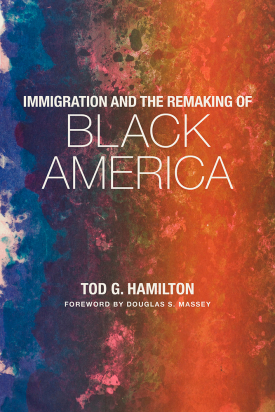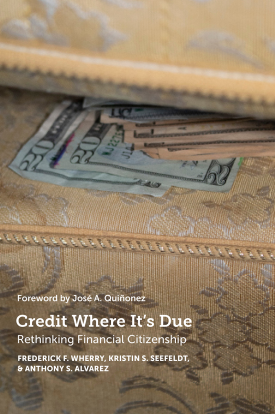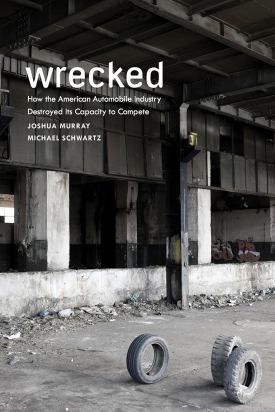
Immigration and the Remaking of Black America
About This Book
Winner of the 2020 Otis Dudley Duncan Award for Outstanding Scholarship in Social Demography
Honorable Mention for the 2020 Thomas and Znaniecki Award from the International Migration Section of the American Sociological Association
“Using the best available data, state-of-the-art analytical strategies, and sophisticated theoretical framing, Immigration and the Remaking of Black America offers the definitive statement about the diverse experiences of black immigrants to the United States and how they compare to their native-born African American counterparts. Professor Hamilton has unquestionably raised the bar for future scholars who would seek to further advance our understanding of this important, but heretofore poorly understood, population.”
—STEWART E. TOLNAY, S. Frank Miyamoto Professor Emeritus of Sociology, University of Washington
“In the most comprehensive study to date of voluntary black immigration to the United States, Tod Hamilton conducts a tempered and temperate demolition on cherished conventional claims about race, national origin, immigration, and social outcomes. Hamilton’s systematic comparisons of the characteristics and experiences of recent black immigrants vis-à-vis their fellow nationals who remain in their home country, of internal black migrants to the north vis-à-vis those blacks who remained in the south, and of recent black immigrants vis-à-vis the native black American population writ large eradicate cultural-cum-behavioral explanations for ongoing racial inequality in the United States. Immigration and the Remaking of Black America is a masterful study.”
—WILLIAM A. DARITY JR., Samuel DuBois Cook Professor of Public Policy, Professor of African and African American Studies, and Professor of Economics, Duke University
“Immigration and the Remaking of Black America teaches us what it means to be black in America today. Its author, Tod G. Hamilton, provides a timely and accessible theoretical and empirical demographic benchmark describing America’s newest black immigrants. More importantly, Hamilton sets today’s black immigrant experience in comparison with native-born black Americans, who still feel the ancestral sting of forced migration from a much earlier and shameful period in U.S. history. America’s burgeoning immigrant and refugee populations from sub-Saharan Africa are too often overlooked but can tell us a great deal about contemporary race relations, race and class dynamics, and immigrant integration in a multiracial society. Immigration and the Remaking of Black America fills the current void.”
—DANIEL T. LICHTER, Ferris Family Professor, Cornell University
Over the last four decades, immigration from the Caribbean and sub-Saharan Africa to the U. S. has increased rapidly. In several states, African immigrants are now the primary drivers of growth in the black population. While social scientists and commentators have noted that these black immigrants’ social and economic outcomes often differ from those of their native-born counterparts, few studies have carefully analyzed the mechanisms that produce these disparities. In Immigration and the Remaking of Black America, sociologist Tod Hamilton shows how immigration is reshaping black America. He weaves together interdisciplinary scholarship with new data to enhance our understanding of the causes of socioeconomic stratification among both the native-born and newcomers.
Hamilton demonstrates that immigration from the Caribbean and sub-Saharan Africa is driven by selective migration, meaning that newcomers from these countries tend to have higher educational attainment and better health than those who stay behind. As a result, they arrive in the U.S. with some advantages over native-born blacks, and, in some cases, over whites. He also shows the importance of historical context: prior to the Civil Rights Movement, black immigrants’ socioeconomic outcomes resembled native-born blacks’ much more closely, regardless of their educational attainment in their country of origin. Today, however, certain groups of black immigrants have better outcomes than native-born black Americans—such as lower unemployment rates and higher rates of homeownership—in part because they immigrated at a time of expanding opportunities for minorities and women in general. Hamilton further finds that rates of marriage and labor force participation among native-born blacks that move away from their birth states resemble those of many black immigrants, suggesting that some disparities within the black population stem from processes associated with migration, rather than from
nativity alone.
Hamilton argues that failing to account for this diversity among the black population can lead to incorrect estimates of the social progress made by black Americans and the persistence of racism and discrimination. He calls for future research on racial inequality to disaggregate different black populations. By richly detailing the changing nature of black America, Immigration and the Remaking of Black America helps scholars and policymakers to better understand the complexity of racial disparities in the twenty-first century.
TOD G. HAMILTON is assistant professor of sociology at Princeton University.
RSF Journal
View Book Series
Sign Up For Our Mailing List
Apply For Funding

Credit Where It’s Due
About This Book
“Working hard and playing by the rules still casts aside millions. Credit Where It’s Due tells the inspiring story of the Mission Asset Fund’s pathway to belonging and financial citizenship. Inspired and well crafted, this book builds the case for making and illuminates how to make citizenship, immigrant integration, and democracy work for organizations, advocates, and anybody committed to building a better society.”
—THOMAS M. SHAPIRO, director and David R. Pokross Professor of Law and Social Policy, Institute on Assets and Social Policy, The Heller School, Brandeis University
“Credit Where It’s Due is an original and masterful examination that goes well beyond the crowded scholarly field of finance and economic exploitation to document the ways in which systems of finance stratify society in areas as basic as human decency, belonging, and recognition. But, far from simply a doom and gloom story, the book presents financial alternatives grounded in the depth of contemporary personal narratives of how finance can be dignity affirming and structured to empower rather than socially degrading and exploitive. This book will advance the field in profound ways.”
—DARRICK HAMILTON, executive director, Kirwan Institute for the Study of Race and Ethnicity, The Ohio State University
An estimated 45 million adults in the U.S. lack a credit score at time when credit invisibility can reduce one’s ability to rent a home, find employment, or secure a mortgage or loan. As a result, individuals without credit—who are disproportionately African American and Latino—often lead separate and unequal financial lives. Yet, as sociologists and public policy experts Frederick Wherry, Kristin Seefeldt, and Anthony Alvarez argue, many people who are not recognized within the financial system engage in behaviors that indicate their credit worthiness. How might institutions acknowledge these practices and help these people emerge from the financial shadows? In Credit Where It’s Due, the authors evaluate an innovative model of credit-building and advocate for a new understanding of financial citizenship, or participation in a financial system that fosters social belonging, dignity, and respect.
Wherry, Seefeldt, and Alvarez tell the story of the Mission Asset Fund, a San Francisco-based organization that assists mostly low and moderate-income people of color with building credit. The Mission Asset Fund facilitates zero-interest lending circles, which have been practiced by generations of immigrants, but have gone largely unrecognized by mainstream financial institutions. Participants decide how the circles are run and how they will use their loans, and the organization reports their clients’ lending activity to credit bureaus. As the authors show, this system not only helps clients build credit, but also allows them to manage debt with dignity, have some say in the creation of financial products, and reaffirm their sense of social membership. The authors delve into the history of racial wealth inequality in the U.S. to show that for many black and Latino households, credit invisibility is not simply a matter of individual choices or inadequate financial education. Rather, financial marginalization is the result of historical policies that enabled predatory lending, discriminatory banking and housing practices, and the rollback of regulatory protections for first-time homeowners.
To rectify these inequalities, the authors propose common sense regulations to protect consumers from abuse alongside new initiatives that provide seed capital for every child, create affordable short-term loans, and ensure that financial institutions treat low- and moderate income clients with equal respect. By situating the successes of the Mission Asset Fund in the larger history of credit and debt, Credit Where It’s Due shows how to prioritize financial citizenship for all.
FREDERICK F. WHERRY is professor of sociology at Princeton University.
KRISTIN S. SEEFELDT is associate professor of social work and associate professor of public policy at the University of Michigan.
ANTHONY S. ALVAREZ is assistant professor of sociology at California State University, Fullerton.
RSF Journal
View Book Series
Sign Up For Our Mailing List
Apply For Funding

Wrecked
About This Book
“The prevailing view holds that union power and unreasonable demands by workers are responsible for the decline of the U.S. auto industry. In this compellingly argued study, Murray and Schwartz challenge that narrative. The problem, Wrecked lucidly argues, is not workers’ actual power. The root of the problem is that U.S. manufacturers are totally unwilling to form a social contract with workers and their unions, choosing total company control despite the fact that means increased costs and decreased flexibility. Anyone interested in reviving U.S. manufacturing needs to read this book.”
—DAN CLAWSON, professor of sociology, University of Massachusetts, Amherst
“It’s almost a truism to lay the decline of the American auto industry at the feet of the trade union movement—for demanding too much, not working hard enough, and in so doing, reducing the competitiveness of the Big Three automakers. But in this brilliant book, Josh Murray and Michael Schwartz place the blame back where it belongs—on the managers and owners and their investment decisions. Whereas Japanese competitor firms based their production model on increasing labor productivity, the Big Three turned increasingly to a low-wage, low-cost model—which quickly lost ground to rival producers. The result has been nothing short of catastrophic for millions of workers in the heartland of American manufacturing. Wrecked sets the record straight. It will take its place as a classic in economic sociology.”
—VIVEK CHIBBER, professor of sociology, New York University
At its peak in the 1950s and 1960s, automobile manufacturing was the largest, most profitable industry in the United States and residents of industry hubs like Detroit and Flint, Michigan had some of the highest incomes in the country. Over the last half-century, the industry has declined, and American automakers now struggle to stay profitable. How did the most prosperous industry in the richest country in the world crash and burn? In Wrecked, sociologists Joshua Murray and Michael Schwartz offer an unprecedented historical sociological analysis of the downfall of the auto industry. Through an in-depth examination of labor relations and the production processes of automakers in the U.S. and Japan both before and after World War II, they demonstrate that the decline of the American manufacturers was the unintended consequence of their attempts to weaken the bargaining power of their unions.
Today Japanese and many European automakers produce higher quality cars at lower cost than their American counterparts thanks to a flexible form of production characterized by long-term sole suppliers, assembly and supply plants located near each other, and just-in-time delivery of raw materials. While this style of production was, in fact, pioneered in the U.S. prior to World War II, in the years after the war, American automakers deliberately dismantled this system. As Murray and Schwartz show, flexible production accelerated innovation but also facilitated workers’ efforts to unionize plants and carry out work stoppages. To reduce the efficacy of strikes and combat the labor militancy that flourished between the Depression and the postwar period, the industry dispersed production across the nation, began maintaining large stockpiles of inventory, and eliminated single sourcing. While this restructuring of production did ultimately reduce workers’ leverage, it also decreased production efficiency and innovation. The U.S. auto industry has struggled ever since to compete with foreign automakers, and formerly thriving motor cities have suffered the consequences of mass deindustrialization.
Murray and Schwartz argue that new business models that reinstate flexible production and prioritize innovation rather than cheap labor could stem the outsourcing of jobs and help revive the auto industry. By clarifying the historical relationships between production processes, organized labor, and industrial innovation, Wrecked provides new insights into the inner workings and decline of the U.S. auto industry.
JOSHUA MURRAY is Assistant Professor of Sociology at Vanderbilt University.
MICHAEL SCHWARTZ is Distinguished Teaching Professor of Sociology at Stony Brook University.
Download
RSF Journal
View Book Series
Sign Up For Our Mailing List
Apply For Funding
New York City has initiated efforts to close the large Rikers Island jail complex and replace it with several smaller jails which are expected to be safer. To close Rikers, the number of inmates must be reduced by over 40 percent, a reduction that represents both a change in municipal administration and fundamental criminal justice reform. The Rikers population has fallen from 11,100 to 8,300 over the last four years largely through decreases in crime and arrests, changes in strategies to diversion and alternatives to incarceration, and quicker resolution of cases.
Co-funded with the Carnegie Corporation
Since 1990, the U.S.
Pagination
- Previous page
- Page 30
- Next page
